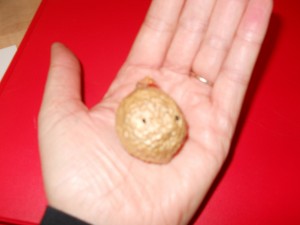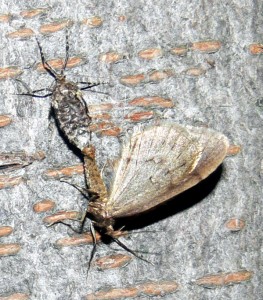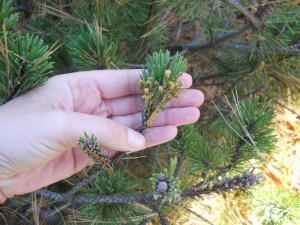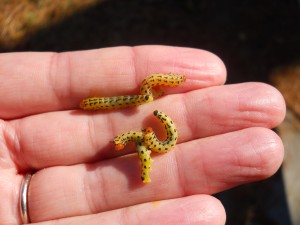A crisp brown ball, light and almost hollow, rests on the ground like squirrel’s toy ball. The papery outside holds a light pithy center. Two small holes breech the dome like the secret holes in the ends of eggs blown for Russian decorating.
“Is this a puff ball?” a student asks, seeing one later on my desk. No, it isn’t . It is an oak apple gall, the home of the oak apple gall wasp (Amphibolips confluenta). This particular wasp was laid in the tissue of an oak leaf by tiny mother wasp, who injected an egg that triggered the oak leaf tissue to grow into this small home. The larva developed there, and as I can see by the holes in the gall, has escaped.
For the most part these galls don’t hurt the trees, and they make for an interesting food web. They also give us a little bit of history. Oak galls are famous as a source of gallotannic acid, once fermented and mixed with iron to form a dark ink (iron gall ink), the standard writing ink of Europe for seven centuries.
Galls are quite common on plants. These outgrowths or overdevelopments of tissue often take characteristic forms depending on the type of organisms that triggers them and the plant they are on. Usually they provide a home for an insect or mite, although sometimes they are more like a tumor, caused by bacteria or a virus. Cedar apple galls, orange fleshy aliens attached to cedar trees- reminiscent of some horror films, are caused by a fungus.
One gall you might be familiar with is the goldenrod stem gall. This hard swelling in the stem of a goldenrod is full of a dense whitish tissue. Cut open it will reveal a wriggling fly larvae (Eurosta solidaginis). Empty, it will look like a hard lump in a goldenrod. While it is developing, the larva eats the stem from the inside. Its saliva causes the plant tissue to grow abnormally. The larva spends almost a year inside the stem, growing, pupating and finally emerging as an adult who will live only two weeks and won’t eat. When they are in the gall, larvae may be eaten themselves- by birds like chickadees. Can you imagine that the chipper, “Chicka dee dee” really means, “yum! I found a fly maggot in this hard abnormal growth” ? Two tiny species of wasps prey only on goldenrod gall flies- by parasitizing them.
Oh, but goldenrods are not the helpless victims you might imagine. Some plants produce a reaction called “hypersensitive necrosis” in order to protect themselves when they are infected or parasitized. This is quite common with bacterial infections but can also happen with insects and other invaders. The plants essentially sacrifice some cells by killing them, and wall off a pathogen or in this case, a larva, so that it dies – a grisly death that can only be imagined by readers of Poe.
Galls can look like skin tags, warts, lumps, hedgehogs, appalling tumors, artichokes, caterpillars, wooly marbles, corn kernals, small lumps, and every imaginable bump and mound. The ones I see most often – the oak leaf galls and the golderod stem gall, hold the creepy hope of new life, and the promise of plant survival by a continual fight against invasion.
For more on galls:
http://www.maine.gov/agriculture/pesticides/gotpests/diseases/factsheets/galls-cornell.pdf
For more on goldenrod gall fly:
http://www.fcps.edu/islandcreekes/ecology/goldenrod_gall_fly.htm
more on the hypersensitive response: http://www.icb.ufmg.br/labs/leeb/publicacoes/1990.Fernandes.pd
iron gall ink
http://en.wikipedia.org/wiki/Iron_gall_ink




